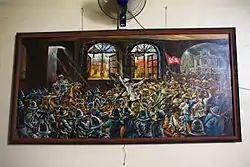| Battle of San Rafael | |||||||
|---|---|---|---|---|---|---|---|
| Part of the Philippine Revolution | |||||||
 | |||||||
| |||||||
| Belligerents | |||||||
|
|
| ||||||
| Commanders and leaders | |||||||
|
|
| ||||||
| Strength | |||||||
| unknown | unknown | ||||||
| Casualties and losses | |||||||
| Heavy | Light | ||||||
The Battle of San Rafael fought between Filipino revolutionaries under the leadership of Anacleto “Matanglawin” Enriquez against the Spanish army headed by Commandant Lopez Arteaga.[1]
Attack
On their way from the town of Paombong, Bulacan to the mountain ranges of Bulacan, General Isidoro Torres of Malolos decided to divide the troop of Katipuneros into two: one group under his supervision while the other under the guidance of General Enriquez and his brother Colonel Vicente Enriquez. The group of General Enriquez was supposedly heading to the town of Baliuag, Bulacan but decided to stay instead in San Rafael, believing it to be a strategic site. Unknowingly, a Spanish troop from Manila heading towards San Rafael, prepared to silence the Filipino insurgents. The battle started at around 7 a.m. on November 30, 1896. The Spanish forces were so strong that General Enriquez ordered a retreat to the San Rafael. Sometime in the middle of the battle, some of the Filipino troops including Colonel Enriquez were separated from the rest of the group and headed to the town of Bigaa (now Balagtas). At around noon, the Spanish army forced the church doors open and murdered the Filipino revolutionaries seeking shelter in the church. It is estimated that nearly 800 people were killed in the battle, most of whom were children and other locals.
Aftermath
The number of casualties was so immense that it was believed that blood spilled in the church reached ankle-deep.[2] The gobernadorcillo of San Rafael ordered a mass grave to be made near the church.[3] It is believed that the Battle of San Rafael inspired the young general Gregorio Del Pilar (a close friend of General Anacleto Enriquez) to join the revolution against Spain.[1]
References
- 1 2 Almario [ed.], Virgilio (2002). Bulacan: Lalawigan ng Bayani at Bulaklak. Pamanang Bulacan Foundation, Inc. ISBN 971-92469-0-1.
{{cite book}}:|last1=has generic name (help) - ↑ Official Website of the Provincial Government of Bulacan. "Bulacan, Philippines: San Rafael, Bulacan: History". bulacan.gov.ph. Retrieved May 24, 2014.
- ↑ Official Website of the Municipal Government of San Rafael. "Historical Glimpse – the Official Website of the Municipality of San Rafael, Bulacan, Philippines". sanrafael.gov.ph. Retrieved May 24, 2014.